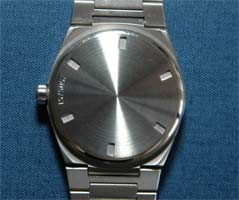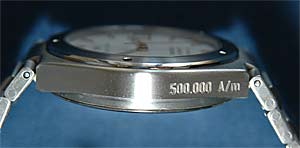
The ref. 3508 and her relatives with automatic movement (cal. 3759x)
 |
1989-1992/93: The «Ingenieur 500,000 A/m»
The ref. 3508 and her relatives with automatic movement (cal. 3759x) |
deutsche Version |
| previous range | back to overview | next range |
The «Ingenieur 500,000 A/m» stands for one of the most glorious failures in IWC’s later history, and a failure she was in at least a commercial sense. During the early eighties, IWC had developed two exceptional amagnetic movements based on the ETA calibre 2892: first the Porsche compass watch (ref. 3551 with calibre 37541 and 37542) and then the «Minentaucheruhr» for the German Bundeswehr (ref. 3519 with cal. 3755AM). After that, IWC planned to commercialise the acquired technical know-how by developing a durable and even more resistant calibre for a new leader model of their «Ingenieur» line. The goal was to make the movement itself amagnetic rather than to shield it in a soft iron Farraday’s cage against magnetic fields as it was done in the previous models.
The expectations were even surpassed when the new calibre 35790 set a new world record surviving a field of 3.9 million A/m. These astonishing results were achieved by a set of technical innovations, including using rubies as rotor ball-bearings, a special amagnetic material for pallet fork and roller, as well as a new alloy (niobium-zirconium) for the balance spring.In 1989 (or late in 1988) the new flagship was released, its name and case proudly stating the fact that the factory guaranteed it could resist magnetic fields up to 500,000 A/m. But soon technical problems emerged. For the calibre 35790 proved to be quite sensible to temperature changes. The troubles were caused by the hairspring whose new alloy lacked the isochronous characteristics which we take for granted in a modern watch. Basically, IWC ended up with a model which kept accurate time even on the rather rare occasion when the movement was exposed to extremely high magnetic fields, but which tended to get out of step in the more likely event of a sudden jump in temperature.
Of course, IWC tried everything to save its prestigious project. But its engineers found no solution how the niobium-zirconium balance spring could be mass produced with a reliable isochronous quality. For a time, each hairspring was individually tested for its temperature characteristics, and only the best suited were hand-picked for production (only a few per mil according to M. Fitz). This procedure ensured that the «Ingenieur 500,000» met IWC's high internal standards, but was of course probihitive. Most probably, it didn’t cure the fundamental problem of the movement’s susceptibility. After four years and less than 3000 pieces produced*, IWC replaced the «500,000 A/m» with the ref. 3521, a more conventional model, yet graced by an official chronometer certificate.
Today (2004), the «Ingenieur 500.000 A/m» has often been regarded as a sleeper. The model is well remembered for its innovation and technical sophistication, but can still be bought at reasonable prices. With its low production number, it’s a very collectible watch, definitely from a technical point of view, but also historically. The calibre 37590 can furthermore testify against all those simplistic views which crave for inhouse movements and disqualify whole companies and lines only because of their use of bought-in ebauches. The Ingenieur 500.000 A/m» stands as an extreme example how IWC uses its technical expertise to adapt bought-in movements until they show completely different characteristics than the original, be it – one might add – for better or worse.
For a fuller story of the «Ingenieur 500.000 A/m» see Christian Niemann, The Ingenieur 500’000 A/m - A sleeping Cinderella, in the articles section of the English IWC-forum.
For the production problems which lead to the replacement by the «Officially Certified Chronometer» see also: Manfred Fitz, Der «Ingenieur» ist nichts zu schwer, Watch 1993/2, p.41
* Information about production number vary. Officially published sources talk of 2706 or 2755 pieces produced, but as Chr. Niemann pointed out to me, this number may include double countings and thus be far too high. In Sept. 2003, he estimated that just 1415 pieces were produced at all .
Specifications:

| previous range | back to overview | next range |